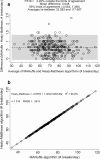Deriving objectively-measured sedentary indices from free-living accelerometry data in rural and urban African settings: a cost effective approach
- PMID: 31511063
- PMCID: PMC6739927
- DOI: 10.1186/s13104-019-4606-4
Deriving objectively-measured sedentary indices from free-living accelerometry data in rural and urban African settings: a cost effective approach
Abstract
Objectives: To investigate the agreement between two data reduction approaches for detecting sedentary breaks from uni-axial accelerometry data collected in human participants. Free-living, uni-axial accelerometer data (n = 318) were examined for sedentary breaks using two different methods (Healy-Matthews; MAH/UFFE). The data were cleaned and reduced using MAH/UFFE Analyzer software and custom Microsoft Excel macro's, such that the average daily sedentary break number were calculated for each data record, for both methods.
Results: The Healy-Matthews and MAH/UFFE average daily break number correlated closely (R2 = 99.9%) and there was high agreement (mean difference: + 0.7 breaks/day; 95% limits of agreement: - 0.06 to + 1.4 breaks/day). A slight bias of approximately + 1 break/day for the MAH/UFFE Analyzer was evident for both the regression and agreement analyses. At a group level there were no statistically or practically significant differences within sample groups between the two methods.
Keywords: Accelerometer; Measurement; Movement monitor; Sedentarism.
Conflict of interest statement
The author declares no competing interests.
Figures


References
-
- Bellettiere J, Healy GN, LaMonte MJ, Kerr J, Evenson KR, Rillamas-Sun E, et al. Sedentary behavior and prevalent diabetes in 6,166 older women: the Objective Physical Activity and Cardiovascular Health Study. J Gerontol A Biol Sci Med Sci. 2019;74:387–395. doi: 10.1093/gerona/gly101. - DOI - PMC - PubMed
MeSH terms
LinkOut - more resources
Full Text Sources
Medical

